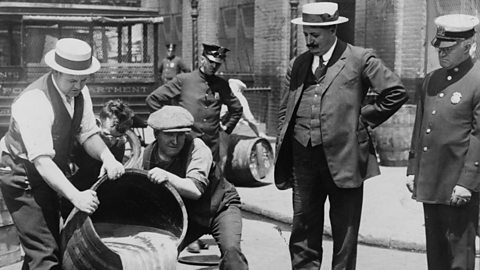Inequality
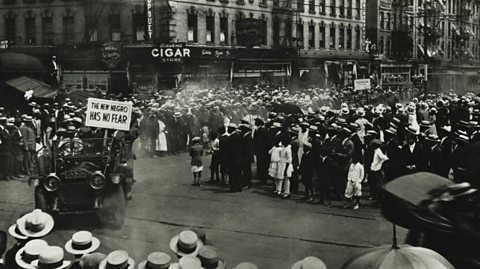
Even though the US constitutionRules by which a country is organised and governed. stated that all its citizens should be treated equally, the reality for black Americans was very different.
In 1920, there were 12 million black Americans living in the USA with 75 per cent of them living in the south.
Legal restrictions affected every aspect of their lives.
Jim Crow laws
Although slavery had ended in 1865, black Americans in the Southern states suffered more discriminationTreating people differently on the basis of a particular characteristic, such as race, religion or sex. than those in the North.
This was because of a set of laws in the South called the Jim Crow laws.
Black Americans were segregationThe enforced separation of different racial or ethnic groups by providing separate public services and facilities, such as schools, libraries and waiting rooms. in churches, hospitals, theatres, schools, toilets, cemeteries, housing, transport, parks and other public places.
This kept black Americans in inferior positions in society, politics and the economy.
Segregation
The Jim Crow lawsThe Jim Crow laws were state and local laws introduced in the Southern United States in the late 19th and early 20th centuries that enforced racial segregation. legalised a system called segregation.
This separated the daily lives of black Americans from the white community.
Even though equality was guaranteed under the US Constitution, segregation was seen as legally acceptable because the US Supreme CourtThe highest court in the country. In the US, it is made up of nine judges, who rule on cases where people claim that the US Constitution has been broken. had ruled that black people could be âseparate but equalâ.
Education
Schools for black Americans were deliberately kept inferior which meant that they would remain uneducated and not advance in society.
Many could not access any form of education and illiteracyThe inability to read or write. was high.
Voting
Black Americans had the right to vote, but in order to vote a person had to be legally registered to do so.
There were specific Jim Crow lawsThe Jim Crow laws were state and local laws introduced in the Southern United States in the late 19th and early 20th centuries that enforced racial segregation. that stopped them registering:
Pay a poll tax: This was a tax that had to be paid to register. Due to low wages, many black Americans were too poor to pay the tax and were therefore unable to vote.
Pass a literacy test: People could be asked to prove that they could read difficult extracts from texts, but literacy levels were low amongst black Americans so few were able to pass. Some states had intelligence tests with deliberately vague answers, making them impossible to pass.
The grandfather clause: In some states, a âgrandfather clauseâ was introduced. This meant that anyone with a father or grandfather who could vote before slavery ended in the USA, were exempt from taking a literacy test (or, in some states, didn't have to pay a poll tax). In effect, this only applied to white people, as before the end of slavery most black Americans were enslaved and had no voting rights.
These policies were both deliberate and very effective.
During the 1870s, 90 per cent of black males were registered to vote.
By 1930 it was 30 per cent.
There were counties in the state of Mississippi with a majority population of black Americans - and yet not one black male was registered to vote.
Employment
Black Americans were forced to work in low paid, unskilled jobs.
This was made worse by the poor education they received.
The majority were not able to benefit from the flourishing economy of the 1920s.
Most black Americans in the South were sharecroppers.
These were farm workers who only got a payment based upon the annual harvest.
They suffered when agricultural prices fell throughout the 1920s and early 1930s.
Three-quarters of a million lost their jobs.
The Ku Klux Klan (KKK)
The Ku Klux Klan was a racist group which began in the southern states at the end of the American civil warA war fought between two or more armies from the same country. in 1865.
It believed in the superiority of white culture, in the supremacy of white Protestants who were ânativeâ to the USA (i.e. the original immigrants to America) and in terrorising black Americans into remaining an enslaveTo take away a personâs freedom and make them work for nothing. people.
It had practically disappeared but was revived in 1915 when a film called The Birth of a Nation depicted them as the protectors of white America.
It grew rapidly and had almost five million members in the mid-1920s.
Members of the KKK had to be White Anglo Saxon Protestants (WASPS) and they also campaigned against Jews, Catholics, communistSomeone who believes in the political ideology of communism, a system of running a country in which all means of production such as tools, factories and raw materials, are owned by the community as a whole. Private property does not exist and each individual contributes according to their ability and receives according to their needs. This means there is no hierarchy of social class. and immigrants.
It drew its membership from all walks of life, from the richest members of the white community to the poorest.
This made them very powerful, particularly in the small towns of the South.
Additionally, there was a significant number of policemen in the KKK and this allowed the group to operate without facing the full force of the law.
Many lawyers, teachers and local politicians also held Klan membership.
Reasons for the growth of the KKK in the early 1920s
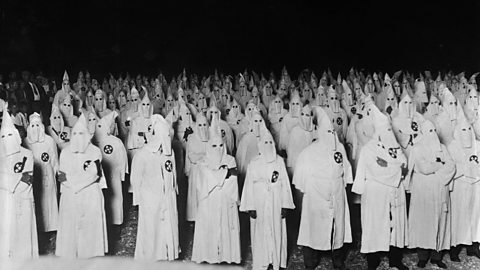
In 1919, there were race riots in 23 cities, including Chicago.
This alarmed some white Americans who saw black Americans as a threat.
The KKKâs emphasis on morality was attractive to many.
For example, a lot of people were worried by women smoking and drinking in public, wearing shorter skirts and visiting illegalspeakeasyA place that sold alcoholic beverages illegally during Prohibition in the 1920s in the USA..
It exploited racist attitudes held in small towns in both the North and the South.
It played on peopleâs fears that mass immigration might lead to unemployment, communism, corruption, alcohol abuse and un-American ideas.
It used professional promoters, such as Edward Y Clarke and Elizabeth Tyler, and modern techniques in the media to promote its propaganda.
CongressThe legislative body of the US government, made up of the Senate and the House of Representatives. hearings into their activities gave them nationwide publicity.
The activities of the KKK
The KKK became known for the following activities:
- They wore white robes and hoods. This was supposed to represent the ghosts of ConfederateThe Confederate states in America decided to secede, meaning break away, from the United States, over the issue of slavery, and fought against the union during the American Civil War. This was known as the Confederacy, and existed from February 1861 to May 1865. soldiers.
- They marched and held rallies, often burning crosses as a symbol of their Christianity.
- They used violent intimidation against the black American communities and were active in preventing them from registering to vote.
- They carried out lynchingTo execute someone, usually by hanging them. This type of execution is a punishment that is carried out by a mob and without a formal trial or the proper authorities being involved.. These were mob killings of black Americans without trial, known as âRope Lawâ.
- In total, over 400 black Americans were lynched by the KKK in the 1920s.
Members of the KKK were seldom punished because:
- Many of the KKK held positions of authority, such as judges, so Klan members were not found guilty in the courts.
- The local police often stood by and did nothing to help victims, sometimes they even took part in the killings.
- It was difficult for the government to change the long-held attitudes of white people in the south.
- Politicians did not take action because they were afraid of losing votes among local white communities.
Reasons for the decline of the KKK
The huge growth of the KKK in the early 1920s was matched by its equally spectacular decline from 1925 onwards.
By 1928, its membership had fallen to a few hundred thousand mainly because the KKKâs claim to stand for traditional values was undermined when D C Stephenson, the Indiana Grand Dragon, was found guilty of kidnapping and raping a young white girl in 1925.
His trial publicised the unsavoury nature of the KKK.
However, the KKK did not disappear completely and remained a frightening presence in the lives of black Americans.
The experience of black Americans in the northern states
In the 1920s, the growth of huge industrial cities in the Northern states and the experience of segregationThe enforced separation of different racial or ethnic groups by providing separate public services and facilities, such as schools, libraries and waiting rooms. in the South, led to one million black Americans from the South migrating to these areas to look for work.
In this Great Migration most of them moved to cities such as New York (300,000), Chicago (250,000), Philadelphia and Detroit where the industrial factories offered employment opportunities.
Life was hard for black Americans in the North; even though there was no legal segregation, they faced racial discrimination and exploitation.
Many of the jobs they received were low quality and lowly paid. For example, as a result of racism and poor education, 60 per cent of black American women in Milwaukee worked as domestic servants.
The wages of black workers did not match those of white people doing the same job.
Car factories in Detroit only hired black Americans in small numbers; most operated an all-white policy. They could do this as they were private companies.
When unemployment increased, they were the first to be sacked. It was black Americans who suffered the most during the Great DepressionA global economic crisis that started in 1929 in the USA. It led to mass unemployment and hardship throughout the 1930s..
By 1933, over half of black Americans in the North were dependent on government support.
As many white districts would not accept them, they lived in poorly maintained ghettoA poor part of a city that is usually occupied by a minority group., that were overcrowded.
There was hostility from white people. Race riots, such as those in Chicago and 23 other cities in 1919, were common as there was tension over the competition for jobs and housing.
Black American cultural reaction
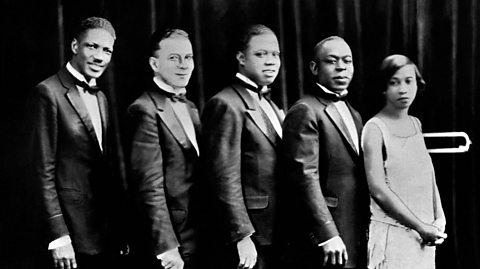
Black Americans expressed their frustrations at discriminationTreating people differently on the basis of a particular characteristic, such as race, religion or sex. through their music and literature.
A unique culture flourished in the 1920s, especially in inner city areas, like Harlem in New York.
Music, such as jazz became popular and drove the Harlem Renaissance.
When jazz was banned in a number of cities, performers moved to the speakeasyA place that sold alcoholic beverages illegally during Prohibition in the 1920s in the USA..
Thus, young white people were influenced by black American culture.
Their theatres attracted big audiences. Comedians, actors and dancers, such as Josephine Baker, had very successful shows.
A number of musicians became very famous, including Louis Armstrong and Bessie Smith.
Black American political reaction
A number of political organisations emerged to represent the issues of black Americans.
There were two main groups in the 1920s and each one had some limited success.
The NAACP
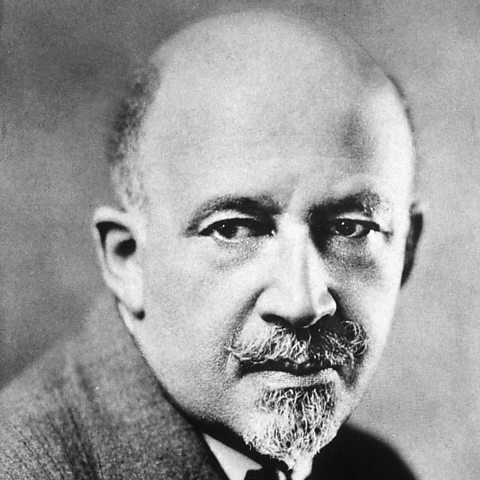
The National Association for the Advancement of Coloured People (NAACP), led by William du Bois, grew rapidly.
In 1919, it had 90,000 members in 300 branches.
It wanted to make black Americans more aware of their civil rights Rights everyone is entitled to regardless of the colour of their skin, their beliefs, sexuality, sex or other personal characteristics. These rights could include - amongst other things - the right to vote, the right to free speech or the right to a good education. and to campaign for the abolition of segregationThe enforced separation of different racial or ethnic groups by providing separate public services and facilities, such as schools, libraries and waiting rooms. , the right to vote and equality in education.
It used legal action and non-violent activities as ways of improving the lives of black Americans.
The number of lynchingTo execute someone, usually by hanging them. This type of execution is a punishment that is carried out by a mob and without a formal trial or the proper authorities being involved. decreased when the findings from a NAACP investigation into this criminal activity caused a public outcry.

Universal Negro Improvement Association (UNIA)
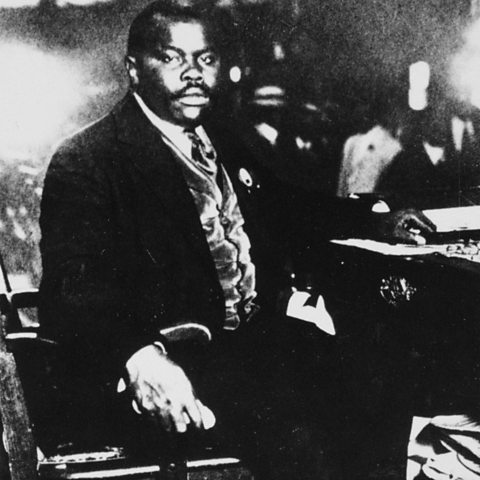
The Universal Negro Improvement Association (UNIA) was led by Marcus Garvey and had over one million members in 1921.
Its aim was to increase black American pride in their colour, culture and history.
âBlack is beautifulâ was his most famous slogan.
UNIA members were more militantUsing strong or violent action in support of a political cause. than the NAACP.
UNIA had some success.
It encouraged black Americans to set up their own businesses such as those in the Bronzeville area of Chicago and to boycott large shops which did not employ black Americans.
It set up the Black Star steamship company to take black Americans back to their racial homeland, but Garvey was arrested for fraud in 1923 and deported.
William du Bois and Marcus Garvey both tried to improve conditions for black people, but their methods were so different that they became sworn enemies.
Therefore, the campaigns of these groups were marred by disputes.

Test your knowledge
More on Life in the United States of America, 1920-33
Find out more by working through a topic
- count2 of 9
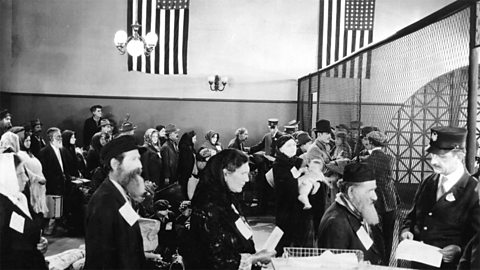
- count3 of 9

- count4 of 9
